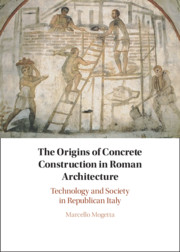 The Origins of Concrete Construction in Roman Architecture
The Origins of Concrete Construction in Roman Architecture Published online by Cambridge University Press: 15 June 2021
Drawing together the evidence gathered in the previous chapters, the concluding discussion concentrates on the historical implications of the revised chronology. Highlighting the existence of simultaneous developments in both core and periphery, the chapter offers a reassessment of the agency of indigenous communities and of their independent contributions to the development of Roman building methods and architecture. Taking the political and economic integration of Late Republican Italy into account, it also suggests a new model for the diffusion of the technology, acknowledging how elite networks may have influenced the mobility of skilled craftsmen and, therefore, technological transfer.
To save this book to your Kindle, first ensure [email protected] is added to your Approved Personal Document E-mail List under your Personal Document Settings on the Manage Your Content and Devices page of your Amazon account. Then enter the ‘name’ part of your Kindle email address below. Find out more about saving to your Kindle.
Note you can select to save to either the @free.kindle.com or @kindle.com variations. ‘@free.kindle.com’ emails are free but can only be saved to your device when it is connected to wi-fi. ‘@kindle.com’ emails can be delivered even when you are not connected to wi-fi, but note that service fees apply.
Find out more about the Kindle Personal Document Service.
To save content items to your account, please confirm that you agree to abide by our usage policies. If this is the first time you use this feature, you will be asked to authorise Cambridge Core to connect with your account. Find out more about saving content to Dropbox.
To save content items to your account, please confirm that you agree to abide by our usage policies. If this is the first time you use this feature, you will be asked to authorise Cambridge Core to connect with your account. Find out more about saving content to Google Drive.